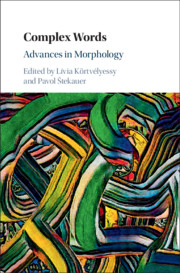Book contents
- Complex Words
- Complex Words
- Copyright page
- Dedication
- Contents
- Contributors
- Introduction: Advances in Morphology
- Part I Lexico-Semantic Aspects of Complex Words
- Part II Structure of Complex Words
- 7 Estonian Case Inflection Made Simple
- 8 Uninflectedness
- 9 Complex Exponents
- 10 Derivational Patterns in Proto-Basque Word Structure
- 11 The Complexity of Greek Verbal Morphology
- 12 Affixoids
- Part III Corpus-Based Case Studies
- Index
- References
9 - Complex Exponents
from Part II - Structure of Complex Words
Published online by Cambridge University Press: 18 September 2020
- Complex Words
- Complex Words
- Copyright page
- Dedication
- Contents
- Contributors
- Introduction: Advances in Morphology
- Part I Lexico-Semantic Aspects of Complex Words
- Part II Structure of Complex Words
- 7 Estonian Case Inflection Made Simple
- 8 Uninflectedness
- 9 Complex Exponents
- 10 Derivational Patterns in Proto-Basque Word Structure
- 11 The Complexity of Greek Verbal Morphology
- 12 Affixoids
- Part III Corpus-Based Case Studies
- Index
- References
Summary
Much of contemporary linguistics presumes that affixes are monomorphemic. I discuss the opposite perspective, according to which complex affixes may themselves arise through the conflation of simpler affixes. The evidence in favor of this perspective is extensive and varied. As I show, this includes evidence of the following sorts: an affix may be paradigmatically opposed to a combination of affixes; two affixes may overlap in both their form and the content that they express; an affix’s alignment may vary according to whether it is alone or accompanied by some other affix; the content expressed by a combination of affixes may not be directly deducible from the content of those individual affixes; and the appearance of an affix in some word form may depend on the presence of a more peripheral affix in that word form. I explain the theoretical significance of this evidence with particular attention to its implications for developing an inferential-realizational theory of inflectional morphology.
Keywords
- Type
- Chapter
- Information
- Complex WordsAdvances in Morphology, pp. 159 - 174Publisher: Cambridge University PressPrint publication year: 2020

